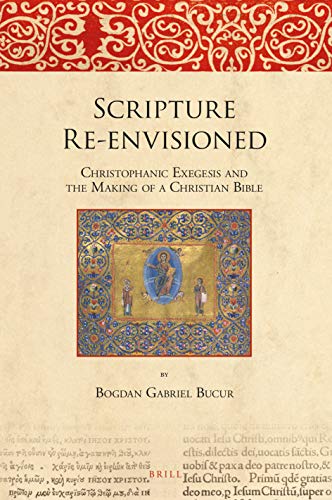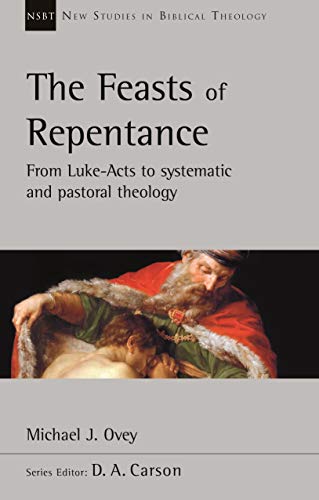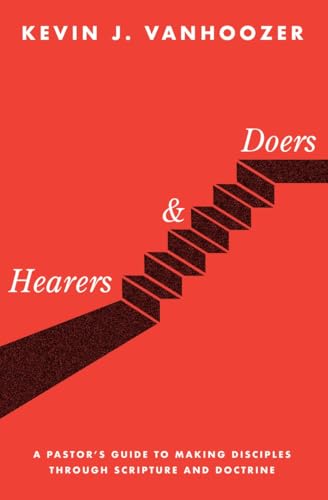Scripture Re-Envisioned: Christophanic Exegesis and the Making of a Christian Bible
Written by Bogdan Bucur Reviewed By John Bush (with Hans Madueme)Bogdan Bucur is a Romanian scholar working from within the Orthodox tradition. In his recent book, Scripture Re-Envisioned: Christophanic Exegesis and the Making of a Christian Bible, Bucur seeks to help the church reflect more carefully on the presence of Christ in Scripture, especially the Old Testament. A patristic scholar, Bucur seeks to enrich the church’s vision through not only exegetical but also hymnographic, iconographic, and liturgical ressourcement.
In his introduction, Bucur presents his fundamental problem with the current state of scholarship. For most thinkers, patristic exegesis of the Old Testament is divided more or less neatly into allegorical (ordinarily associated with Alexandrian theologians) and typological (centered on Antiochian thinkers) categories (p. 4). Allegorical and typological categories, however, fail to do justice to the conviction of early Christians that Jesus was personally present in the Old Testament in narrative after narrative. In order to make this case, Bucur painstakingly traces the reception history of biblical narratives in the early church from Genesis to Luke.
The cornerstone of Bucur’s case comes from Christ’s meeting with his disciples on the road to Emmaus in Luke 24. In this story, two disciples of the Lord are “kept from recognizing” Christ as he accompanies them on their journey (Luke 24:16). Jesus then “beginning with Moses and all the Prophets … interpreted to them in all the Scriptures the things concerning himself” (24:27), but the disciples still do not recognize his true identity. Later, the disciples finally recognize Christ’s identity when He breaks bread and gives it to them (vv. 30–31). Bucur sees several facets of this text, which form the methodological guidelines for his book as a whole. He notes that the disciples must (1) have their misapprehensions of Scripture connected, (2) submit to a discipleship relationship with Jesus, (3) root their exegesis in a sacramental apprehension of Christ, and (4) enter into Scripture with a “proper medium and method of christological exegesis” (p. 9).
Bucur’s perspective (vindicated by a careful examination of patristic texts) is that the early Christian church saw this story in Luke 24 as analogous to the church’s reception of the Old Testament. Once blind to the presence of Christ in the Old Testament (John 3:10; Luke 16:29–31), God’s people had received further revelation from Jesus and were given new eyes so that his presence is manifest. This re-envisioning of the text is linked to the “breaking of bread” and therefore “to speak of theophanic visions and revelations is only possible from the vantage point of liturgical experience” (p. 33).
Bucur leverages this paradigm to explain the reception history of a series of Old Testament theophanies in the early church. Patristic authors discerned Christ’s presence in the burning bush from which God spoke to Moses (Exod 3), Isaiah’s vision of the divine throne room (Isa 6), Daniel’s vision of the Son of Man (Dan 7) and numerous other Old Testament passages. His analysis of the church fathers is fair-minded and incorporates detailed analysis of data which might be in tension with his thesis. I personally found his exploration of Moses’s vision of God in Exodus 33 to be particularly helpful. In this section, Bucur examines the connection between the Sinai theophany and the revelation of Christ’s true glory on Mount Tabor in Matthew 17, a connection patristic theologians utilized extensively.
These reception-histories make up the bulk of Bucur’s book, but the last chapter summarizes and offers a new model which he calls “re-envisioning” to describe the exegetical method of early Christians. The main blind spot he sees in modern scholarship is failure to acknowledge that early Christians saw not only a type or allegory but instead the divine Lord Himself in Old Testament narratives. The same Lord early Christians met in the liturgy was present in the Old Testament but “not as a matter of exegetical and theological convention but an epiphanic self-evidence” (p. 265). In other words, typology and allegory presume something is absent but hinted at; the universal conviction of the early church, however, was that Christ was unequivocally present in the Old Testament. Bucur does not embrace proposals to describe Christian exegesis as a “rewritten Bible.” As he points out, this category better describes groups (common in the Second Temple period) who literally rewrote sacred texts in conformity with their theological agendas. As Bucur notes, however, the “rewritten” texts of patristic exegetes “do not constitute a new text, but offer new readings of the existing ones” (p. 271, italics in original). Instead, he proposes that we view the early Christian exegesis as “re-envisioning” Scripture in light of further revelation and finally perceiving the divine Lord who had always been present. Christ is, after all, “retrospectively revealed to have accompanied the disciples all along” as they journeyed to Emmaus (p. 275).
Overall, Scripture Re-Envisioned not only lives up to Brill’s traditional high price tag but also the high standard of scholarship that readers expect from the imprint. Meticulously researched and well argued, this book will be useful to readers interested in Christian engagement with the Old Testament or patristic theology. The book’s rigor, however, means it will be quite the slog for anyone without a substantial background in hermeneutics or patristic theology. Readers of this journal will also need to approach the book with eyes wide open. Bucur’s Orthodox theological convictions shine through on every page. At points Bucur’s eagerness to map Christian reception through the lenses of hymnography, iconography, and liturgy reflects a decentering of Scripture. For Protestants accustomed to writers who reason from the paradigm of sola Scriptura, this may be disorienting. Orthodox ecclesiological, sacramental, and soteriological distinctives also surface in Bucur’s writing but do not shape his central insight in ways which unduly detract from its utility for Protestant theologians.
In summary, this is an excellent book. Bucur approaches the Bible with reverence, treating it as a complete, unified covenantal reality. This enables him to see deep coherence between the parts of Scripture rooted in a recognition that it is Jesus acting to save His people from Genesis to Revelation. Scripture Re-Envisioned should be welcomed, then, by all among God’s people who delight to see the Scriptures opened that they might perceive the presence of their Savior “in all the Scriptures” as Christ modeled for his disciples in Luke 24.
John Bush (with Hans Madueme)
John Bush (with Hans Madueme)
Covenant College
Lookout Mountain, Georgia, USA
Other Articles in this Issue
What are we to make of Cultural Marxism? This article seeks to answer that question, first, by outlining the key elements and legacy of classical Marxism; second, by exploring the neo-Marxism of Antonio Gramsci; third, by assessing the main ideas and impact of “the Frankfurt School”; and, fourth, by offering some reflections on (i) the links between these thinkers and various contemporary developments, (ii) the wisdom of employing the term Cultural Marxism, and (iii) how Christians should respond to the current “culture wars” that are polarizing the Western world.
The diverse essays in Stanley Rosenberg’s edited volume Finding Ourselves After Darwin: Conversations on the Image of God, Original Sin, and the Problem of Evil (Grand Rapids: Baker Academic, 2018) offer a Christian analysis of the human person in light of evolutionary thinking...
Do Formal Equivalent Translations Reflect a Higher View of Plenary, Verbal Inspiration?
by William D. MounceThe article begins by establishing five categories of translation theory and argues that functional translations like the NIV do in fact reflect the meaning of every Greek word, but not in the same way as formal equivalent translations do...






